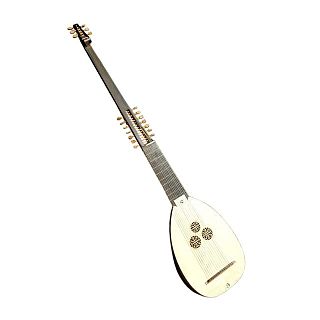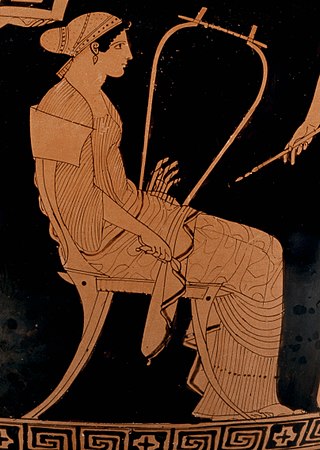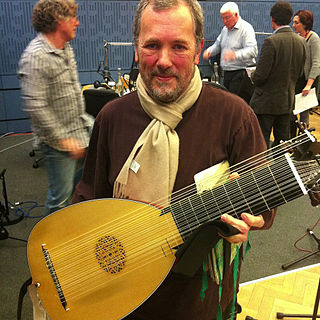A tiorbino, a small theorbo (tiorbo in Italian), is a rare stringed instrument, a type of long-necked lute resembling a theorbo but significantly smaller and pitched an octave higher. The tiorbino was created in the late 16th century and was played in the 17th century, as in the 1622 composition Capricci a due stromenti cioe tiorba e tiorbino e per sonar varie sorti de balli.. by Bellerofonte Castaldi. The tiorbino was then abandoned, only to return in the late 20th century with the renaissance of interest in early music.
The sound of the tiorbino has been described by the lutenist Paul O'Dette as "a cross between a lute, a baroque guitar, and a harp."[ citation needed ] Although the tiorbino is not large, its sound carries well. It was used as a basso continuo instrument and was "a valuable addition to the tonal landscape available to the continuo player."

Figured bass is musical notation in which numerals and symbols appear above or below a bass note. The numerals and symbols indicate intervals, chords, and non-chord tones that a musician playing piano, harpsichord, organ, or lute should play in relation to the bass note. Figured bass is closely associated with basso continuo: a historically improvised accompaniment used in almost all genres of music in the Baroque period of Classical music, though rarely in modern music. Figured bass is also known as thoroughbass.

A lute is any plucked string instrument with a neck and a deep round back enclosing a hollow cavity, usually with a sound hole or opening in the body. It may be either fretted or unfretted.

String instruments, stringed instruments, or chordophones are musical instruments that produce sound from vibrating strings when a performer plays or sounds the strings in some manner.

The theorbo is a plucked string instrument of the lute family, with an extended neck and a second pegbox. Like a lute, a theorbo has a curved-back sound box with a wooden top, typically with a sound hole, and a neck extending out from the soundbox. As with the lute, the player plucks or strums the strings with one hand while "fretting" the strings with the other hand; pressing the strings in different places on the neck produces different pitches (notes), thus enabling the performer to play chords, basslines and melodies.

William Lawes was an English composer and musician.

Basso continuo parts, almost universal in the Baroque era (1600–1750), provided the harmonic structure of the music by supplying a bassline and a chord progression. The phrase is often shortened to continuo, and the instrumentalists playing the continuo part are called the continuo group.
The torban is a Ukrainian musical instrument that combines the features of the Baroque lute with those of the psaltery. The Тorban differs from the more common European bass lute known as the theorbo in that it had additional short unfretted treble strings strung along the treble side of the soundboard.

The lirone is the bass member of the lira family of instruments that was popular in the late 16th and early 17th centuries. It is a bowed string instrument with between 9 and 16 gut strings and a fretted neck. When played, it is held between the legs in the manner of a cello or viol.
The archlute is a European plucked string instrument developed around 1600 as a compromise between the very large theorbo, the size and re-entrant tuning of which made for difficulties in the performance of solo music, and the Renaissance tenor lute, which lacked the bass range of the theorbo. Essentially a tenor lute with the theorbo's neck-extension, the archlute lacks the power in the tenor and the bass that the theorbo's large body and typically greater string length provide.

The barbiton, or barbitos, is an ancient stringed instrument related to the lyre known from Greek and Roman classics.
Giovanni Girolamo Kapsperger was an Austrian-Italian virtuoso performer and composer of the early Baroque period. A prolific and highly original composer, Kapsberger is chiefly remembered today for his lute and theorbo (chitarrone) music, which was seminal in the development of these as solo instruments.

The mandora or gallichon is a type of 18th- and early 19th-century lute, with six to nine courses of strings. The terms were interchangeable, with mandora more commonly used from the mid-18th century onwards.

The angélique is a plucked string instrument of the lute family of the baroque era. It combines features of the lute, the harp, and the theorbo.
Lynda Sayce is a British lutenist and theorbo player, known also as a scholar of musical history and a writer on the history of the lute and theorbo.

Nigel North is an English lutenist, musicologist, and pedagogue.
Timothy Allen Burris is an American lutenist.
Jakob Lindberg is a Swedish lutenist, performing solo, in small and large ensembles, and also directing operas, using instruments of the lute and guitar families. He is known for the first ever recording of the Complete Solo Lute Music of John Dowland as well as for recording music never before recorded, with repertoire dating back to the Renaissance period.
Musica Fiorita was an ensemble for baroque music founded in 1990 and based in Basel, which was conducted by the harpsichordist Daniela Dolci. The ensemble concentrated in particular on rediscovering unknown works by composers of the 17th and 18th centuries and their historical performance practice. In March 2020, it ceased its concert activities.